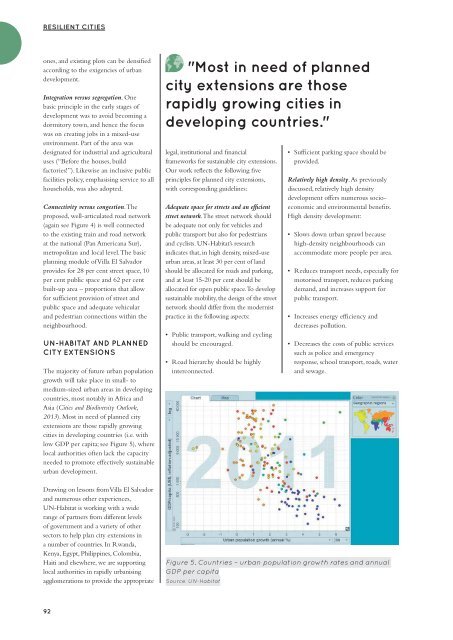Climate Action 2014-2015
You also want an ePaper? Increase the reach of your titles
YUMPU automatically turns print PDFs into web optimized ePapers that Google loves.
RESILIENT CITIES<br />
ones, and existing plots can be densified<br />
according to the exigencies of urban<br />
development.<br />
Integration versus segregation. One<br />
basic principle in the early stages of<br />
development was to avoid becoming a<br />
dormitory town, and hence the focus<br />
was on creating jobs in a mixed-use<br />
environment. Part of the area was<br />
designated for industrial and agricultural<br />
uses (“Before the houses, build<br />
factories!”). Likewise an inclusive public<br />
facilities policy, emphasising service to all<br />
households, was also adopted.<br />
Connectivity versus congestion. The<br />
proposed, well-articulated road network<br />
(again see Figure 4) is well connected<br />
to the existing train and road network<br />
at the national (Pan Americana Sur),<br />
metropolitan and local level. The basic<br />
planning module of Villa El Salvador<br />
provides for 28 per cent street space, 10<br />
per cent public space and 62 per cent<br />
built-up area – proportions that allow<br />
for sufficient provision of street and<br />
public space and adequate vehicular<br />
and pedestrian connections within the<br />
neighbourhood.<br />
UN-HABITAT AND PLANNED<br />
CITY EXTENSIONS<br />
The majority of future urban population<br />
growth will take place in small- to<br />
medium-sized urban areas in developing<br />
countries, most notably in Africa and<br />
Asia (Cities and Biodiversity Outlook,<br />
2013). Most in need of planned city<br />
extensions are those rapidly growing<br />
cities in developing countries (i.e. with<br />
low GDP per capita; see Figure 5), where<br />
local authorities often lack the capacity<br />
needed to promote effectively sustainable<br />
urban development.<br />
Drawing on lessons from Villa El Salvador<br />
and numerous other experiences,<br />
UN-Habitat is working with a wide<br />
range of partners from different levels<br />
of government and a variety of other<br />
sectors to help plan city extensions in<br />
a number of countries. In Rwanda,<br />
Kenya, Egypt, Philippines, Colombia,<br />
Haiti and elsewhere, we are supporting<br />
local authorities in rapidly urbanising<br />
agglomerations to provide the appropriate<br />
"Most in need of planned<br />
city extensions are those<br />
rapidly growing cities in<br />
developing countries."<br />
legal, institutional and financial<br />
frameworks for sustainable city extensions.<br />
Our work reflects the following five<br />
principles for planned city extensions,<br />
with corresponding guidelines:<br />
Adequate space for streets and an efficient<br />
street network. The street network should<br />
be adequate not only for vehicles and<br />
public transport but also for pedestrians<br />
and cyclists. UN-Habitat’s research<br />
indicates that, in high density, mixed-use<br />
urban areas, at least 30 per cent of land<br />
should be allocated for roads and parking,<br />
and at least 15-20 per cent should be<br />
allocated for open public space. To develop<br />
sustainable mobility, the design of the street<br />
network should differ from the modernist<br />
practice in the following aspects:<br />
Public transport, walking and cycling<br />
should be encouraged.<br />
Road hierarchy should be highly<br />
interconnected.<br />
Sufficient parking space should be<br />
provided.<br />
Relatively high density. As previously<br />
discussed, relatively high density<br />
development offers numerous socioeconomic<br />
and environmental benefits.<br />
High density development:<br />
Slows down urban sprawl because<br />
high-density neighbourhoods can<br />
accommodate more people per area.<br />
Reduces transport needs, especially for<br />
motorised transport, reduces parking<br />
demand, and increases support for<br />
public transport.<br />
Increases energy efficiency and<br />
decreases pollution.<br />
Decreases the costs of public services<br />
such as police and emergency<br />
response, school transport, roads, water<br />
and sewage.<br />
Figure 5. Countries – urban population growth rates and annual<br />
GDP per capita<br />
Source: UN-Habitat<br />
92












